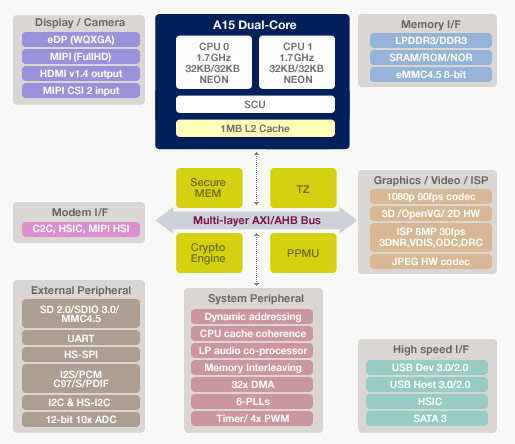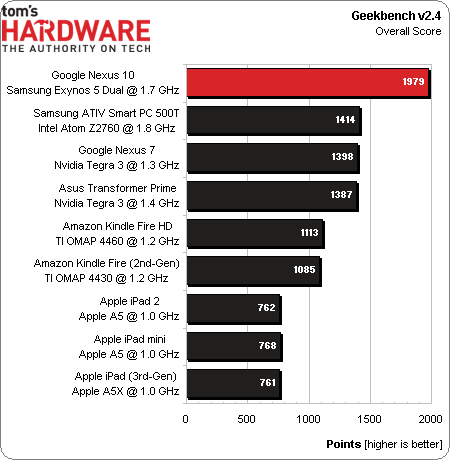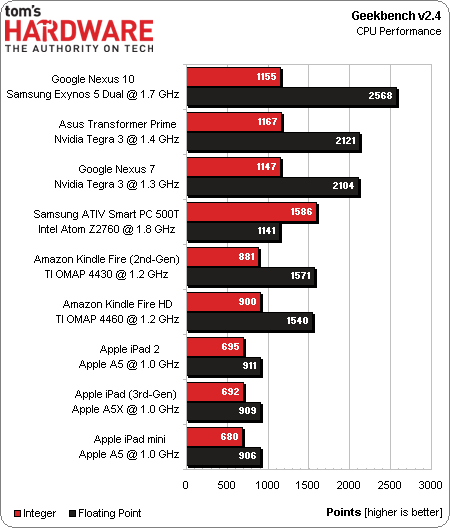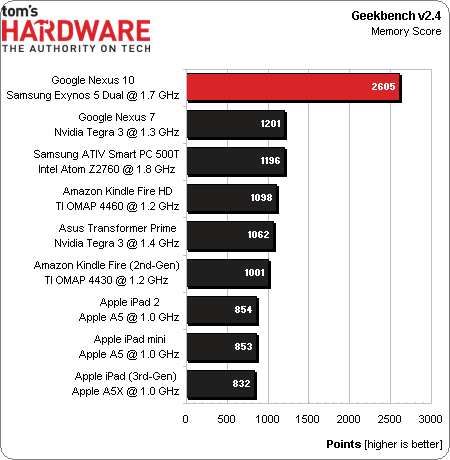Google Nexus 10 Review: Is 2560x1600 High-Def Enough?
Google's Nexus 10 enables a 2560x1600 resolution on a 10" display, and features a powerful Samsung SoC. Can the affordable tablet take down Apple's iPad through superior hardware and better value? We apply our benchmark suite to answer those questions.
Results: CPU Performance
As mentioned, Google's Nexus 10 centers on Samsung's Exynos 5 Dual SoC, formerly referred to as the 5250. The chip couples two Cortex-A15 cores running at 1.7 GHz with ARM's Mali-T604 (the number four indicating quad-core) GPU. Samsung manufacturers the Exynos 5 Dual on its 32 nm high-k metal gate process, which it says results in 30%-lower power consumption than the Exynos 4 Dual manufactured using a 45 nm node. With that said, we're curious to see how it stacks up against Qualcomm's existing S4 Plus and Nvidia's upcoming Tegra 4 SoCs, both of which benefit from a 28 nm process.
We discussed the Cortex-A15 superficially on page two of Snapdragon S4 Pro: Krait And Adreno 320, Benchmarked. Briefly, though, the -A15 employs the ARMv7 instruction set, just like ARM's Cortex-A9 design. The company claims performance up to 40% better than its prior-generation design at a given clock rate, though. Technically, a cluster of four Cortex-A15 cores supports up to 4 MB of L2 cache. But Samsung only arms its Exynos 5 Dual with 1 MB.
Geekbench doesn't reflect real-world performance; however, it's an interesting synthetic that helps demonstrate the relative performance of dissimilar platforms. According to our results, the Exynos 5 Dual's two Cortex-A15 cores deliver 80%+ more performance than the dual-core Cortex-A9s in TI's OMAP 44xx SoCs, albeit operating 500 MHz faster.
The CPU-oriented subtest helps pin down the Exynos 5 Dual's advantage in floating-point-based math (enhanced by the -A15's ability to execute 128 bits at a time), though it trails Intel's Atom Z2760 in the integer component.
But where the SoC really shines is the memory score. Samsung supports LPDDR3, DDR3, and LPDDR2 memory, but we have to imagine the Nexus 10 is armed with 2 GB of 800 MT/s LPDDR3 on its twin 32-bit channels (up to 12.8 GB/s) to post such a commanding lead over the Atom Z2760, which offers up to 6.4 GB/s of throughput via two channels of LPDDR2-800.
Get Tom's Hardware's best news and in-depth reviews, straight to your inbox.
Current page: Results: CPU Performance
Prev Page Can Google's Nexus 10 Beat Apple At Its Own Game? Next Page Results: GPU Performance-
joytech22 The Nexus 10 is one of the most powerful Android devices available, but why?Reply
A T604 can be configured up to what - 8 cores? The Nexus 10 has ONE and it performs just under a PVR 543MP4
The CPU is absolutely monstrous, as is RAM Bandwidth, resolution etc..
I often think to myself - Why aren't other manufacturers sticking specs like these into their own systems? Stick a T604MP4 in there and you've got performance numbers (mind you, numbers likely not real-world) close to 2.5x that of the fastest iPad in every single way (except battery.. Lol).
As for CPU, Stick a 1.7GHz S4 Pro in there with 2GB of RAM and combine it with the same screen.
The company that does that has my next purchase guaranteed. -
killabanks as much as i love this tablet it needs a beefier gpu to handle that res just look what apple crammed in the ipad 4th genReply -
bit_user Why does the Color Temperature graph say "Higher is Better"? That's just wrong. The standard for accurate video reproduction is 6500 Kelvin.Reply
Values higher than that will result in the image having a blue bias. Values lower than that will result is the image appearing reddish. Of course, this also depends on the ambient light, which will influence how the image is perceived. But 6.5k Kelvin was supposedly chosen to match natural daylight.
-
neon neophyte i disagree completely about the screen analysis. it is most obvious on the picture of the blue flower. with the nexus 10 i can see all the detail in the pedals, the ipad is over saturated and has lost its detail.Reply -
killerclick There was an article a while ago that showcased Tom's Hardware writers and various devices they use. Almost all of them had an iPad or a Macbook or both.Reply
Just sayin'...
Link is http://www.tomshardware.com/picturestory/605-toms-hardware-editors.html -
bit_user neon neophytei disagree completely about the screen analysis. it is most obvious on the picture of the blue flower. with the nexus 10 i can see all the detail in the pedals, the ipad is over saturated and has lost its detail.Well, as they didn't say what camera they used or how it was configured, you have to assume they didn't disable AWB and that they used autofocus (which can have unpredictable results, when photographing a screen). Even if they avoided those two pitfalls, we don't know anything about the camera's spectral response function. Alone, that would be enough to disqualify any such comparison. Add to that the effects of your display device (I'll bet it's never been calibrated), and you should see that you really can't trust how these images show the respective screens.Reply
They also used images that are so vivid and almost artificial that it's sometimes hard to tell which display is reproducing the images more faithfully.
-
neon neophyte eh, they said in the article that we could see the difference in the pictures. then they went on to say those pictures reflected that the ipad was better.Reply
i disagree completely. -
bit_user neon neophyteeh, they said in the article that we could see the difference in the pictures. then they went on to say those pictures reflected that the ipad was better.i disagree completely.I'm not disagreeing with you. I'm just pointing out that their methodology seems badly flawed.Reply
If they want to learn how to write better video reviews, Tom's could do worse than to check out David Katzmaier's reviews, on CNet.
-
senshu neon neophyteeh, they said in the article that we could see the difference in the pictures. then they went on to say those pictures reflected that the ipad was better.i disagree completely.You're nowhere close to alone on this.Reply



